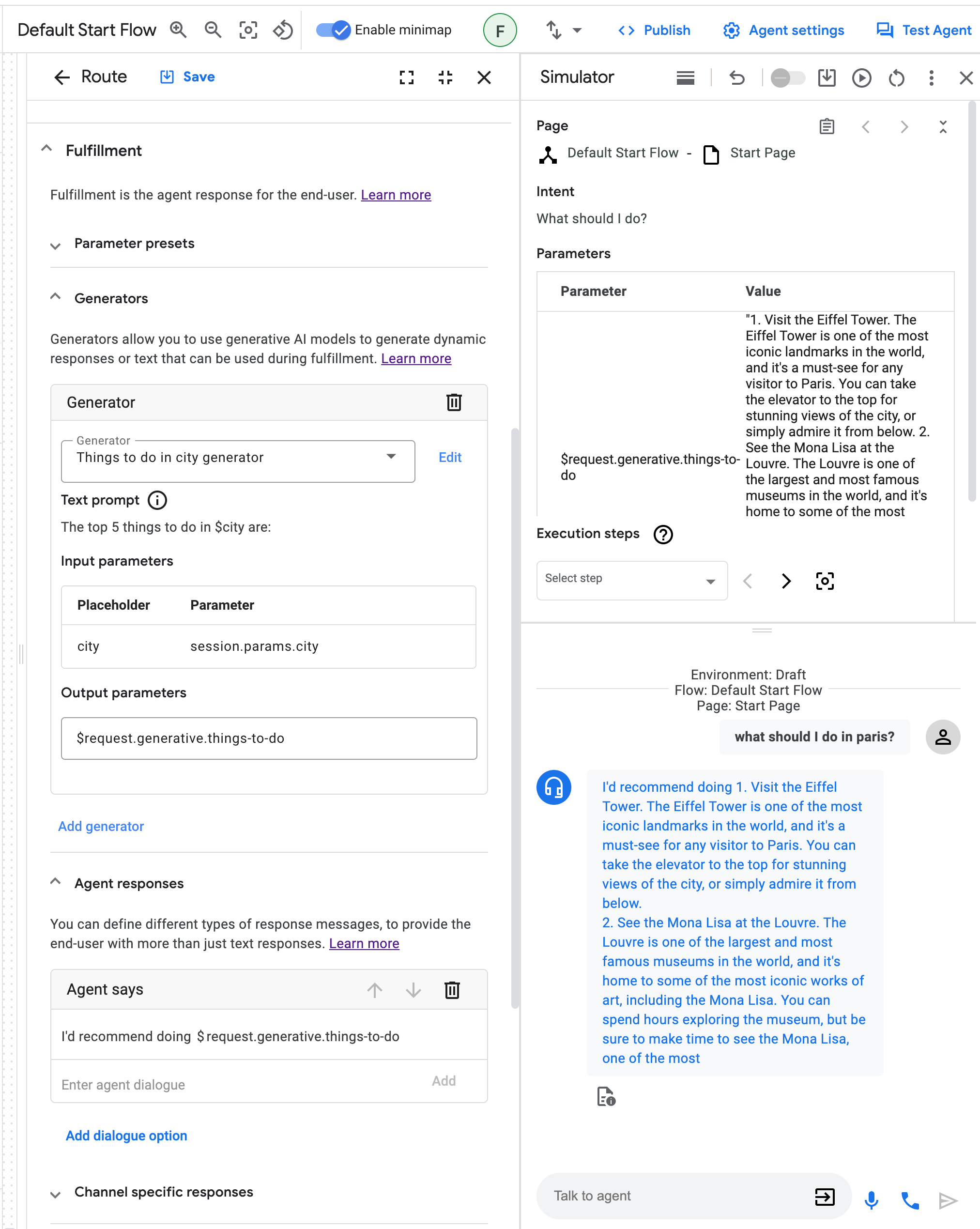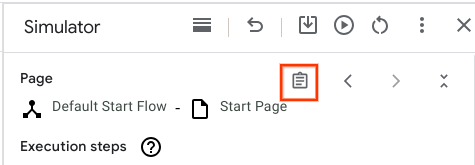I generatori utilizzano i modelli linguistici di grandi dimensioni (LLM) generativi più recenti di Google e i prompt che fornisci per generare il comportamento e le risposte dell'agente in fase di esecuzione. I modelli disponibili sono forniti da Vertex AI.
Un generatore ti consente di effettuare una chiamata a un modello LLM in modo nativo da Conversational Agents (Dialogflow CX) senza dover creare il tuo webhook esterno. Puoi configurare il generatore in modo che esegua qualsiasi operazione che normalmente chiederesti a un modello LLM.
I generatori sono ideali per attività come la sintesi, l'estrazione di parametri, le trasformazioni dei dati e così via. Consulta gli esempi di seguito.
Limitazioni
Questa funzionalità è disponibile per gli agenti in qualsiasi lingua di Dialogflow, anche se i modelli disponibili potrebbero avere limitazioni linguistiche più restrittive. Per ulteriori informazioni, consulta Vertex AI.
Informazioni sui concetti relativi ai generatori
La documentazione di Vertex AI contiene informazioni importanti da comprendere quando crei generatori per Dialogflow:
- Modelli (modelli di base di Google e versioni e ciclo di vita dei modelli)
- Prompt
- Controlli (chiamati "valori parametro" in Vertex AI)
Definisci un generatore
Per creare un generatore:
- Vai alla console Dialogflow CX.
- Selezionare il tuo progetto Google Cloud.
- Seleziona l'agente.
- Fai clic sulla scheda Gestisci.
- Fai clic su Generatori.
- Fai clic su Crea nuovo.
- Inserisci un nome visualizzato descrittivo per il generatore.
- Inserisci il prompt di testo, il modello e i controlli come descritto in concetti.
- Fai clic su Salva.
Il prompt di testo viene inviato al modello generativo durante l'elaborazione in fase di esecuzione. Deve essere una domanda o una richiesta chiara affinché il modello generi una risposta soddisfacente.
Puoi rendere il prompt contestuale contrassegnando le parole come segnaposto aggiungendo un $ prima della parola. In un secondo momento, puoi associare questi sostituenti della richiesta del generatore ai parametri di sessione durante l'elaborazione e questi vengono sostituiti dai valori dei parametri di sessione durante l'esecuzione.

Esistono sostituzioni per i prompt del generatore speciali che non devono essere associate ai parametri di sessione. Questi sostituenti del prompt del generatore integrati sono
| Termine | Definizione |
|---|---|
$conversation |
La conversazione tra l'agente e l'utente, esclusa l'ultima frase dell'utente e le frasi dell'agente successive. |
$last-user-utterance |
L'ultima frase dell'utente. |
Utilizzare un generatore nell'evasione
Puoi utilizzare i generatori durante l'elaborazione (in Routes, Event-handlers, Parameters e altro ancora).
Vai alla sezione Generatori del riquadro Fulfillment ed espandila. Poi, fai clic su Aggiungi generatore. Ora puoi selezionare un generatore predefinito o definire un nuovo generatore.
Dopo aver selezionato un generatore, devi associare i sostituenti della richiesta del generatore della richiesta ai parametri della sessione. Per farlo, devi
definire il parametro di output che conterrà il risultato del generatore
dopo l'esecuzione. Inserisci un nome per il parametro di output nel campo Parametri di output, ad esempio things-to-do. Questo parametro di output verrà scritto in un parametro di sessione
a cui puoi fare riferimento in futuro.
Puoi quindi utilizzare il parametro di output per fare riferimento al risultato del generatore in un secondo momento, ad esempio nella risposta dell'agente:I'd recommend doing $session.params.things-to-do.
Per ulteriori informazioni sul formato e sull'utilizzo dei parametri, consulta la documentazione relativa ai parametri.
Testare un generatore
La funzionalità del generatore può essere testata direttamente nel simulatore.

Esempi
Questa sezione fornisce esempi di casi d'uso per i generatori. Poiché i generatori sono una tecnologia generativa basata su modelli linguistici di grandi dimensioni (LLM), i risultati individuali ottenuti utilizzando i seguenti prompt di esempio potrebbero essere diversi dall'output documentato qui. Tutti i risultati dei prompt restituiti da Google sono basati su un impegno di massima.
Sintesi dei contenuti
Questo esempio mostra come riassumere i contenuti.
Prompt:
Your goal is to summarize a given text.
Text:
$text
A concise summary of the text in 1 or 2 sentences is:
Riepilogo delle conversazioni
Questo esempio mostra come fornire un riepilogo della conversazione.
Prompt:
You are an expert at summarizing conversations between a User and an Agent.
When providing the summary, always start with "Dear $email_address, the conversation summary is as follows:"
Provide a summary in a few bullet points.
Try to be as brief as possible with each bullet point,
only noting the key points of the conversation.
Output the summary in markdown format.
Conversation:
$conversation
Summary:
Prompt risolto:
Per una conversazione di esempio, il prompt risolto inviato al modello generativo potrebbe essere:
You are an expert at summarizing conversations between a User and an Agent.
When providing the summary, always start with "Dear joe@example.com conversation summary is as follows:"
Provide a summary in a few bullet points.
Try to be as brief as possible with each bullet point,
only noting the key points of the conversation.
Output the summary in markdown format.
Conversation:
Agent: Good day! What can I do for you today?
User: Hi, which models can I use in Conversational Agents (Dialogflow CX)'s generators?
Agent: You can use all models that Vertex AI provides!
User: Thanks, thats amazing!
Summary:
Formattazione Markdown
Questo esempio mostra come formattare il testo in Markdown.
# Instructions
You are presented with a text and your goal is to apply markdown formatting to text.
**NOTE:** Do not change the meaning of the text, only the formatting.
# Example
## Text
Generators allow you to use Googles latest generative models to format text,
or to create a summaries, or even to write code. What an amazing feature.
## Text in Markdown
*Generators* allow you to use Google's latest generative models to
* format text
* create a summaries
* write code
What an amazing feature.
# Your current task
## Text
$text
## Text in Markdown
Question answering
Questa serie di esempi mostra come utilizzare i generatori per rispondere alle domande.
Innanzitutto, puoi semplicemente fare affidamento sulle conoscenze interne del modello generativo per rispondere alla domanda. Tieni però presente che il modello fornirà semplicemente una risposta basata sulle informazioni che facevano parte dei dati di addestramento. Non è garantito che la risposta sia vera o aggiornata.
Richiesta di risposta alle domande con conoscenza di sé
Your goal is to politely reply to a human with an answer to their question.
The human asked:
$last-user-utterance
You answer:
Chiedere di rispondere alle domande con le informazioni fornite
Tuttavia, se vuoi che il modello risponda in base alle informazioni che fornisci, puoi semplicemente aggiungerle al prompt. Questo metodo funziona se non vuoi fornire troppe informazioni (ad esempio il menu di un piccolo ristorante o i dati di contatto della tua azienda).
# Instructions
Your goal is to politely answer questions about the restaurant menu.
If you cannot answer the question because it's not related to the restaurant
menu or because relevant information is missing from the menu, you politely
decline to answer.
# Restaurant menu:
## Starters
Salat 5$
## Main dishes
Pizza 10$
## Deserts
Ice cream 2$
# Examples
Question: How much is the pizza?
Answer: The pizza is 10$.
Question: I want to order the ice cream.
Answer: We do have ice cream! However, I can only answer questions about the menu.
Question: Do you have spaghetti?
Answer: I'm sorry, we do not have spaghetti on the menu.
# Your current task
Question: $last-user-utterance
Answer:
Chiedere di rispondere a una domanda con informazioni fornite in modo dinamico
Spesso le informazioni su cui vuoi basare la risposta del modello sono troppe per essere semplicemente incollate nel prompt. In questo caso, puoi collegare il generatore a un sistema di recupero delle informazioni, come un database o un motore di ricerca, per recuperare dinamicamente le informazioni in base a una query. Puoi semplicemente salvare l'output di questo sistema in un parametro e collegarlo a un segnaposto nel prompt.
# Instructions
Your goal is to politely answer questions based on the provided information.
If you can't answer the question given the provided information, you politely
decline to answer.
# Provided information:
$information
Question: $last-user-utterance
Answer:
Generazione del codice
Questo esempio mostra come utilizzare un generatore per scrivere codice. Tieni presente che in questo caso è sensato utilizzare un modello generativo addestrato specificamente per generare codice.
Prompt
# Instructions:
Your goal is to write code in a given programming language solving a given problem.
Problem to solve:
$problem
Programming language:
$programming-language
# Solution:
Riassegnazione a un agente umano
Questo esempio mostra come gestire la riassegnazione a un agente umano. Le ultime due istruzioni nel prompt impediscono al modello di essere troppo prolisso.
Prompt:
# Instructions:
You are a polite customer service agent that handles requests
from users to speak with an operator.
Based on the $last-user-utterance,
respond to the user appropriately about their request to speak with an operator.
Always be polite and assure the user that you
will do your best to help their situation.
Do not ask the user any questions.
Do not ask the user if there is anything you can do to help them.
# Answer:
Generazione di query di ricerca
Questo esempio mostra come ottimizzare una query della Ricerca Google fornita dall'utente.
Prompt:
# Instructions:
You are an expert at Google Search and using "Google Fu"
to build concise search terms that provide the highest quality results.
A user will provide an example query,
and you will attempt to optimize this to be the best Google Search query possible.
# Example:
User: when was covid-19 first started and where did it originated from?
Agent: covid-19 start origin
# Your task:
User: $text
Agent:
Recupero dei dati del cliente
Questo esempio mostra come eseguire il recupero delle informazioni e la ricerca dei dati forniti in formato stringa o JSON. Questi formati sono comunemente utilizzati dai parametri della sessione Dialogflow.
Prompt:
You are a database engineer and specialize in extracting information
from both structured and unstructured data formats like CSV, SQL, JSON,
and also plain text.
Given a $user_db, extract the information requested
by the user from the $last-user-utterance
EXAMPLE:
user_db: {'customer_name': 'Patrick', 'balance': '100'}
User: What is my current account balance?
Agent: Your current balance is 100.
Begin!
user_db: $user_db
User: $last-user-utterance
Agent:
Aggiornamento di un oggetto JSON
Questo esempio mostra come accettare un oggetto JSON dall'utente (o dal webhook), quindi manipolarlo in base alla richiesta dell'utente.
Prompt:
You are an expert Software Engineer
that specializes in the JSON object data structure.
Given some user $update_request and existing $json_object,
you will modify the $json_object based on the user's $update_request.
EXAMPLE:
json_object = { "a": 1, "b": 123 }
User: Add a new key/value pair to my JSON
Agent: What do you want to add?
User: c: cat
Agent: { "a": 1, "b": 123, "c": "cat"}
json_object = {"accounts": [{"username": "user1", "account_number": 12345}, {"username": "user2", "account_number": 98765}], "timestamp": "2023-05-25", "version":"1.0"}
User: Add a new value for user1
Agent: What do you want to add?
User: birthday, 12/05/1982
Agent: {"accounts": [{"username": "user1", "account_number": 12345, "birthday": "12/05/1982"}, {"username": "user2", "account_number": 98765}], "timestamp": "2023-05-25", "version":"1.0"}
json_object = $json_object
User: Add a new key value to my db
Agent: What do you want to add?
User: $last-user-utterance
Agent:
Codelab
Consulta anche il Codelab Generatori.
Risoluzione dei problemi
Se vuoi eseguire il debug della funzionalità, puoi controllare il prompt di input del modello linguistico di grandi dimensioni (LLM) risolto nel simulatore di Console Dialogflow:
Fai clic sul pulsante Risposta originale:

Individua il campo "Generators LLM Inputs". Leggi questi campi come testo normale e controlla se l'input dell'LLM ha senso. Se una frase contiene
$, esamina l'input del simulatore e chiarisci se i$nei prompt sono intenzionali (ad esempio,$inprice is $10è probabile che sia intenzionale, mentrevisit $cityprobabilmente no e potrebbe implicare un uso improprio o un bug).Se non vedi il campo "Input LLM generativi ", contatta l'assistenza.

